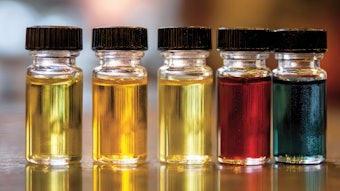
The fragrance industry uses many natural ingredients, such as lavender, jasmine, sandalwood and centifolia oils. The perfumers’ palette also contains thousands of synthetic molecules. Since the development of the first synthetic F&F ingredients in the late 19th century, the chemical processes have evolved significantly. There are evermore synthetic options for perfumers and flavorists. These synthetic materials have allowed fragrances and flavors to become mainstream and accessible to mass markets.1 They go into everything from high-end designer perfumes to laundry detergents and car scents. Today, industry estimates are that petrol-derived ingredients comprise over half the raw materials used in flavors and fragrances.
The non-stop growth of social media has sharpened consumer awareness and increased interest in the source of ingredients used in products they use and purchase. This increased awareness, together with legitimate environmental concerns, is resulting in growing consumer interest and demand for products made from sustainable and renewable sources. Luckily, the fragrance industry can draw on the most abundant essential oil available in nature—turpentine. Turpentine is the volatile fraction of the oleoresin of coniferous trees grown all around the globe.
Turpentine Production
Worldwide, turpentine production in 2020 is estimated to be 325,000 MT. Of this, about 60% undergo a conversion into F&F ingredients.2,3,4 Three commonly used methods for the extraction of turpentine exist. Gum turpentine (GT) is obtained by tapping trees and collecting the exudates. Today, this source represents approximately 40% of the world’s available turpentine. Crude sulfate turpentine (CST) comes from the paper kraft pulp process where volatile materials are removed by applying heat and pressure. This source represents roughly 60% of available turpentine.5 The third method relies on harvesting pine stumps left in the ground from the paper mills and can produce wood turpentine (WT) in limited quantities.
References
- Bomgardner, M. 2019. How Perfumers walk the fine line between natural and synthetic. Chemical & Engineering news. Vol 97, Issue 16. https://cen.acs.org/business/consumer-products/perfumers-walk-fine-line-between/97/i16
- Baumassy, Michel. “Pine Chemicals Industry Global overview and trends”. 2020 Pine Chemicals Virtual Conference. October 1, 2020.
- Baumassy, Michel. “Pine Chemicals Industry Global overview and trends”. 2019 Pine Chemicals International Conference. Vancouver, September 22-24, 2019.
- P.A. Wilbon, F Chu, C. Tang. 2013. “Progress in Renewable Polymers from Natural Terpenes, Terpenoids, and Rosin”. Micromol. Rapid Commun. 2013, 34, 8-37.
- T. Elder. 2004. Chemicals from Wood. USDA – forest service, Pineville, LA USA.
For the full article, please check out the Perfumer & Flavorist+ March 2022 issue.










